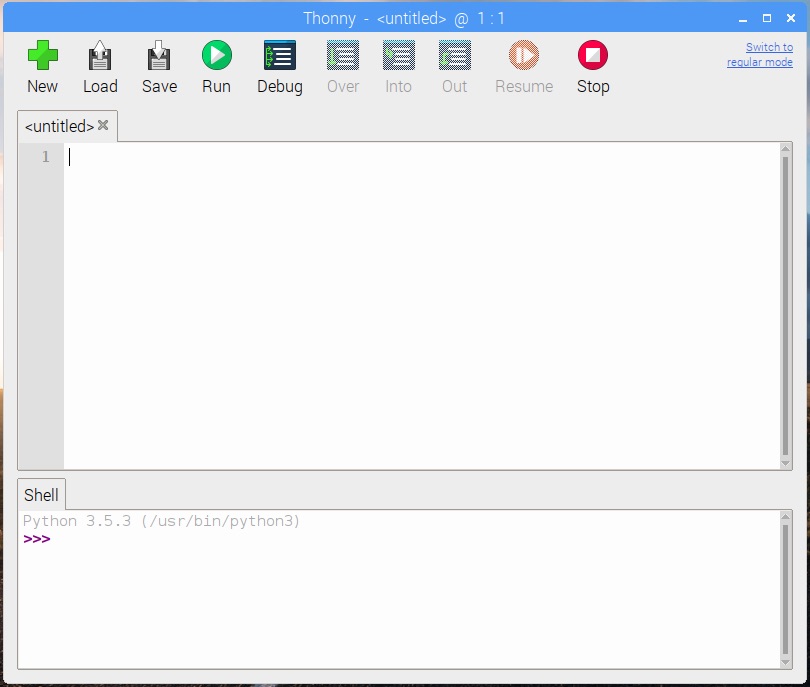

- Run thonny virtual environment install#
- Run thonny virtual environment upgrade#
- Run thonny virtual environment full#
- Run thonny virtual environment windows#
You have the Python Launcher for Windows installed. On Windows, “shebang” line processing is supported if This means that the script will run with that interpreter regardless of the In order to achieve this, scripts installed into virtual environments haveĪ “shebang” line which points to the environment’s Python interpreter, Should be runnable without activating it.
Run thonny virtual environment full#
You don’t specifically need to activate a virtual environment,Īs you can just specify the full path to that environment’sįurthermore, all scripts installed in the environment New in version 3.8: PowerShell activation scripts installed under POSIX for PowerShell Core ( must be replaced by the path to the directory The invocation of the activation script is platform-specific

Python will invoke the environment’s Python interpreterĪnd you can run installed scripts without having to use their full path. This will prepend that directory to your PATH, so that running Sys.prefix != sys.base_prefix to determine if the current interpreter isĪ virtual environment may be “activated” using a script in its binary directory Point to those of the base Python used to create the environment. Whereas sys.base_prefix and sys.base_exec_prefix Point to the directories of the virtual environment, When a Python interpreter is running from a virtual environment, Multiple paths can be given to venv, in which case an identical virtualĮnvironment will be created, according to the given options, at each provided Invoked to bootstrap pip into the virtual environment. Unless the -without-pip option is given, ensurepip will be Run with the -system-site-packages option, false otherwise. Include-system-site-packages key, set to true if venv is The created pyvenv.cfg file also includes the PS C:> Set-ExecutionPolicy -ExecutionPolicy RemoteSigned -Scope CurrentUser Issuing the following PowerShell command: Script by setting the execution policy for the user. On Microsoft Windows, it may be required to enable the Activate.ps1 Sourcing an activate script in its bin directory. Once an environment has been created, you may wish to activate it, e.g.
Run thonny virtual environment upgrade#
upgrade-deps Upgrade core dependencies: pip setuptools to the prompt PROMPT Provides an alternative prompt prefix for this without-pip Skips installing or upgrading pip in the virtualĮnvironment (pip is bootstrapped by default) Of Python, assuming Python has been upgraded in-place. upgrade Upgrade the environment directory to use this version clear Delete the contents of the environment directory if itĪlready exists, before environment creation. Symlinks are the default for the platform. copies Try to use copies rather than symlinks, even when symlinks Try to use symlinks rather than copies, when symlinks

Give the virtual environment access to the system h, -help show this help message and exit Ĭreates virtual Python environments in one or more target directories.ĮNV_DIR A directory to create the environment in. Packages can also be installed from source using a setup.py script using the commands: python setup.Usage: venv
Run thonny virtual environment install#
Once the virtual environment has been installed and activated, packages can be installed normally with pip using the command: pip install To deactivate or leave the environment, run the command: deactivate To confirm that the environment has been activated, use the which command and ensure that it points to the Python interpreter inside the environment directory. To activate the environment, use the command: source /bin/activate Failing to do so will install packages locally to your home directory. Activating and Deactivating a Virtual EnvironmentĪfter creating a virtual environment, it needs to be activated before you can begin installing packages. A common practice is to create this folder inside your project and call it env. This command will create a folder called envname and place the virtual installation of Python inside that folder.

To create a virtual environment using Python use the following command: python -m venv This allows users to be able to install packages and modify their Python environment without fear of breaking packages installed in other environments. Users can then install and manage Python packages for each project. Python virtual environments create a virtual installation of Python inside a project directory.


 0 kommentar(er)
0 kommentar(er)
